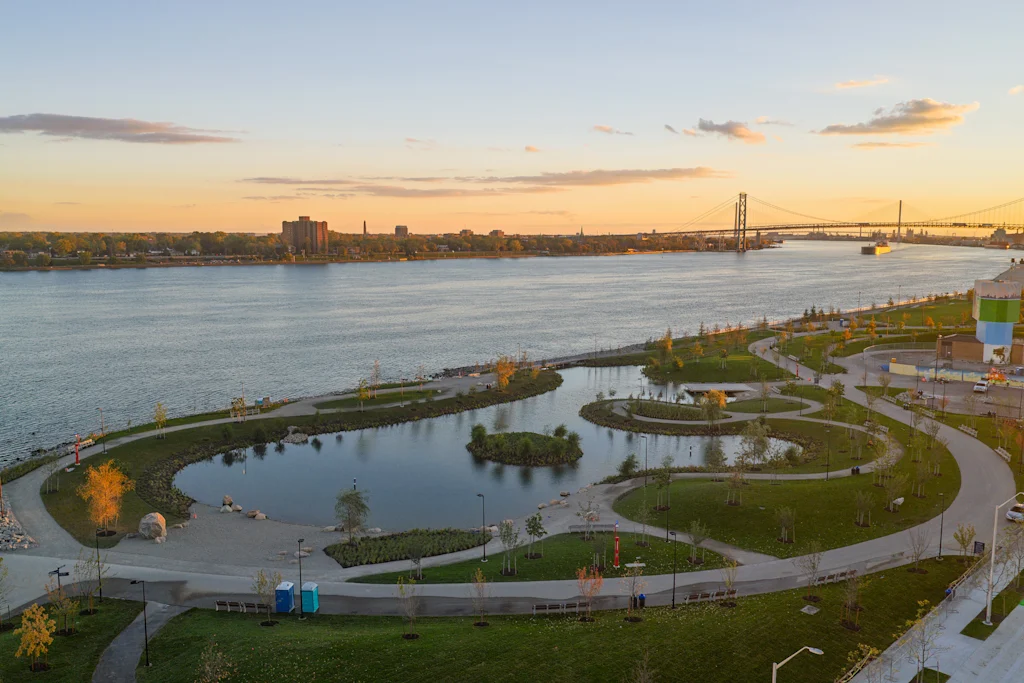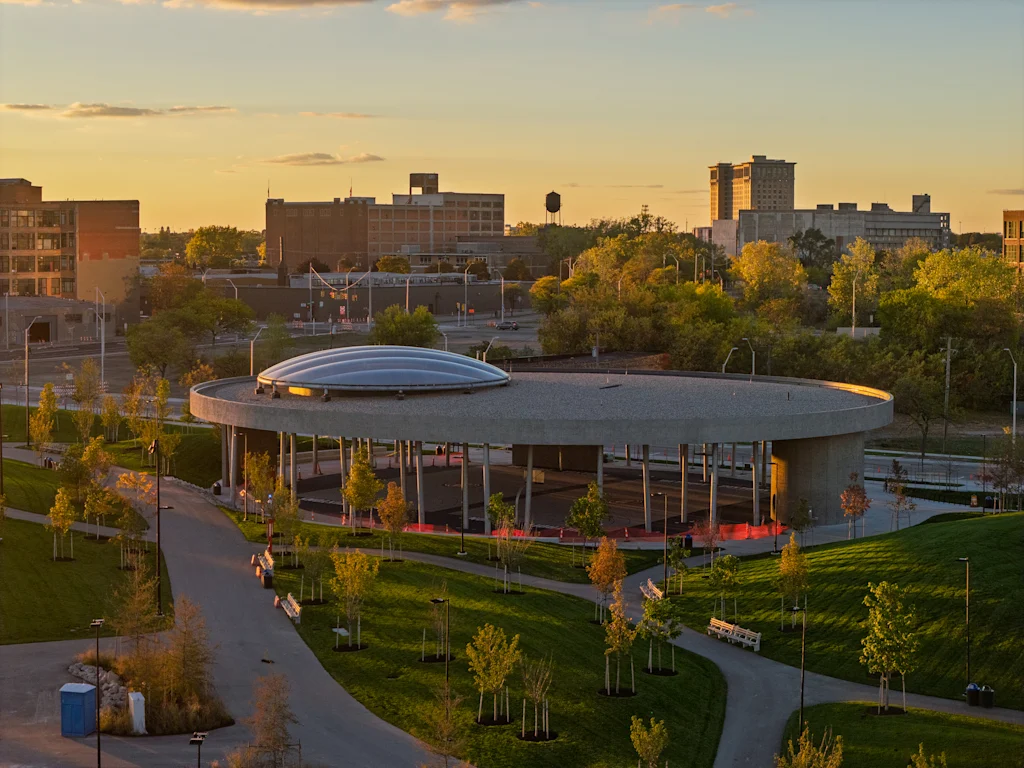America’s next great riverfront park has just opened in Detroit. Covering 22 acres along the Detroit River, Ralph C. Wilson, Jr. Centennial Park is the latest high-profile project to open in a troubled city now on a much-touted rebound. With an $80 million budget buying world class design from two highly regarded firms, it’s a major investment in the city’s public realm. And though a massive embezzlement scandal nearly derailed the project in 2024, the park is now open to the public.
Designed by the landscape architecture firm Michael Van Valkenburgh Associates, Detroit’s new riverfront park is a multidimensional destination intended to draw people from across the region and the age spectrum. Its postcard highlights are specially designed animal-themed playgrounds, a cityscape-framing allée of cherry trees, a covered basketball pavilion designed by Adjaye Associates, and, most uniquely, a two-acre lagoon fed by the river that gives visitors the rare opportunity to come up close and touch the water.
The project was led by the Detroit Riverfront Conservancy, a nonprofit established in 2003 to reconnect the city with a formerly industrial riverfront that had devolved into abandonment and contamination. In the decades since, the organization has invested more than $300 million building out riverfront parks, public spaces, and a nearly 5.5-mile continuous riverwalk along the water. The site of Ralph C. Wilson Park, just west of downtown, had been an underutilized green space for years but suffered by being cut off from its surroundings by a railyard and a derelict parking lot.
Walking through the park a few weeks before its official opening, Detroit Riverfront Conservancy CEO Ryan Sullivan can’t help but marvel at the transformation. The formerly pancake-flat site had a short life as a public park before construction began in 2022, but the space was barely loved. Before that, it had been a rail turning yard and later the site of the printing press for the Detroit Free Press newspaper. Building this new park required laying at least 18 inches of clean dirt on top of what was less than pristine ground. “It was really a blank slate to reimagine what a park could be in this space,” Sullivan says.
The $80 million park was primarily funded by the Ralph C. Wilson, Jr. Foundation, established by the late Detroit native and businessman who was the longtime owner of the Buffalo Bills NFL team. A companion park, also funded by the foundation, is currently being built in Buffalo. “Mr. Wilson was a lifelong Detroiter and he loved the city,” says James Tighe, senior director of parks and trails at the Ralph C. Wilson, Jr. Foundation. “The desire was to make sure that this was representative of the community, but also that it was a world-class destination for the city and for all the residents in the region to enjoy.”

A direct connection to water
Dodging workers laying down sod and construction equipment hauling some of the roughly 900 trees planted in the park, Sullivan and Tighe lead me down a pathway leading to one of the park’s main highlights: a striking playground built around the bowl of an artificial hill. Wooden and metal playscapes inspired by Michigan wildlife, custom-designed by the renowned Danish playground designers Monstrum, rise on the hill’s rim and empty down into a central space.
One of the structures, a giant bear holding up a metal tube slide, has become the de facto mascot of the park. Nearby, a splash pad area features mechanical waterworks that kids can use to pump and divert water down pathways and creek-like channels. Another playground, designed for young children, is a short meander away.
“The playgrounds are something that we just lavished a lot of time and attention on,” says Michael Van Valkenburgh, who is for his work designing Brooklyn Bridge Park, Chicago’s converted railline park the 606, and the landscape around the forthcoming Obama Presidential Center. Van Valkenburgh says he’s had a soft spot for playground design since making it his focus in grad school. But he was also keen to make sure the park appealed to more than just kids. “We wanted the park to have things in it that the range of members of a family would need to have to go to the park and spend some serious time there,” he says.
Working with the Ralph C. Wilson Jr. Foundation and the Detroit Riverfront Conservancy, Van Valkenburgh’s firm engaged directly with 21 Detroiters throughout the design process to help shape the park and its offerings. Starting in 2018, these community members, known as the Community Action Team, worked directly with the designers and went on tours of notable parks in New York, Philadelphia, and Chicago. A clear takeaway from this involvement was the importance of the park as a waterfront experience.
“People wanted to be around the water. They wanted more access to the water,” Sullivan says. “We live in one of the most water abundant places on planet Earth in terms of fresh water. Yet within the city of Detroit, there’s nowhere to actually touch and feel and interact with the water.”
That inspired the idea of bringing river water directly into the park. Van Valkenburgh says the original concept was to create a kind of cove cut upstream from the river, where people could step into the water without fear of falling in and being pulled downstream. But water from the Detroit River—technically a strait between Lake St. Clair and Lake Erie—is beset by contamination from an active shipping channel and combined sewer overflows. Instead, the cove became a lagoon, with no direct human access to the river and a pump system that can be plugged up if contamination levels in the river become too high.
Stepping onto the lagoon’s gravel beach, Sullivan points to the wildlife that has already made the lagoon and its small internal islands home. Geese pad by and cormorants can be seen poking their heads into the water nearby. Turtles, crawfish, and even a mink have been seen on site. “No confirmed fish sightings yet, but I’m waiting on that,” Sullivan says. The lagoon was given enough depth for any eventual fish populations to survive during winters, when the surface is likely to freeze over. Officials are hopeful this could one day create another recreational attraction in the park: ice skating. “That’s a future opportunity,” Sullivan says.

A park for all seasons
For now, the park has plenty else to offer, including a large covered pavilion that holds two NBA-sized basketball courts and space for other programming, as well as a constructed hill that offers panoramic views upstream of the downtown skyline and downstream of the Ambassador Bridge and soon-to-open Gordie Howe International Bridge beyond. The hill also serves as space for winter sledding in a largely flat city.
Making the park work in all seasons was a priority for the designers, and for the community. Van Valkenburgh, who grew up in upstate New York and remembers five foot snow storms, giving kids a place to experience the fun of a white winter was natural. But he also worked to make the park’s design celebrate the unofficial holiday of winter’s end. Cutting across much of the park is a long, straight walkway with views of downtown and the two bridges, and the designers chose to line this walkway with dozens of flowering cherry trees. “No matter how much you love winter, it sucks by the end. It just sucks. It’s like, enough. I love you, but I’m sick of you,” Van Valkenburgh says. “We wanted that explosion of spring.”
One unfortunate but unavoidable element in the park is the existence of a hulking concrete ventilation tower near the center. It’s the above-ground infrastructure of a freight rail tunnel running under the Detroit River to Windsor, Ontario. Standing about five stories tall, it’s an awkward inclusion in an otherwise refined space. But in a way it does help connect the park to its surroundings. It heightens the fact that the park sits adjacent to a rails-to-trails conversion project called the Southwest Greenway, which also connects to the Joe Louis Greenway, a 27-mile loop of trails being built around the city.
The park has one other scar. The park’s construction began in 2022 and was moving forward steadily until news broke in mid-2024 that the Detroit Riverfront Conservancy’s chief financial officer, William A. Smith, had embezzled more than $40 million from the organization over the previous 11 years. (In April, Smith was sentenced to 19 years in prison and ordered to pay roughly $48 million in restitution.)
The revelation was a black eye for the Conservancy and threatened to derail the park project. But according to Tighe, the Ralph C. Wilson, Jr. Foundation was committed to seeing the project through. Within a week of the news, the foundation issued an emergency grant to the conservancy to ensure work continued on schedule for the October 2025 opening. “It was a long year,” Tighe says.
With the park now complete, and an endowment created to supports its ongoing maintenance, the financial scare from the embezzlement may soon just be a bad memory. For most park visitors, walking just feet from the Detroit River or rushing down one of its slides, there will be no visual clue that all this had the potential of collapsing. “It’s really a miracle when you look around,” Sullivan says.

